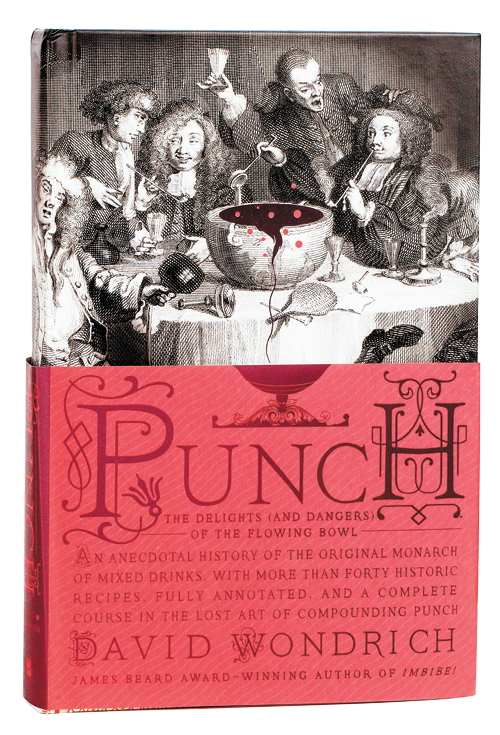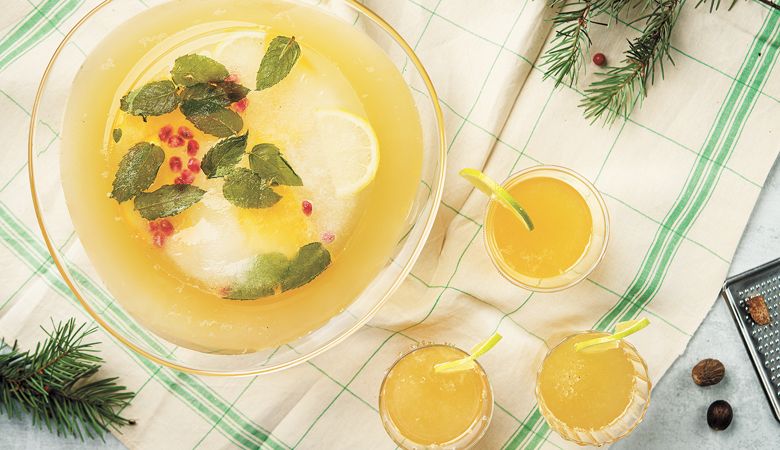Pack More Punch
Make your holidays a hit with a historically cool concoction
We yield to our primordial urge to gather with loved ones around a crackling fire while rain taps at the window or sparkling snowflakes descend. Turning to the past, we embrace tradition and old-fashioned fare to a soundtrack of Christmas carols on vinyl and Perry Como. When darkness closes in before cocktail hour has even begun, we crave the conviviality of sharing food, drink and laughter. Add centuries of tradition and it’s a perfect recipe for punch.
Yes, punch.
True, punch is widely — but wrongly! — scorned. For several generations, punch has been — forgive me — a punchline: the butt of jokes at frat parties and luaus; the rainbow-sherbet-and-7-Up appetite spoiler of kids at cotillions and bar mitzvahs; the flavor tag on Atomic Age drinks like Tropical Punch Kool-Aid and Hawaiian Punch, obliquely acknowledging how the flavor in question has nothing to do with any actual fruit.
It’s no surprise we’ve forgotten that punch once reigned supreme, the ultimate and virtually only way to consume spirits for about two centuries. Born in colonialism and dethroned by the cocktail and its cult of individualism, punch is actually a tasty, varied and respectable libation.
The Original Batched Cocktail
Trend watchers have witnessed the ascendancy of batched cocktails, popular for home entertaining for their do-ahead ease. Make cocktails by the batch, and hosts can enjoy their party instead of laboring at the bar and attending to the individual whims of guests.
Batched cocktail? That’s punch. Before the cocktail was a glimmer in anyone’s eye, dinner hosts were blending spirits with sweet, sour and spice, diluting the concoction to sufficiently tame its fire and serving it in a communal bowl to be ladled and savored.
My suggestion to anyone who likes to entertain: rescue the family punch bowl from the donation pile or, if you are headed to the altar, follow your grandparents’ footsteps and add one to your wedding registry. Punch may have declined into insipid obscurity for a few generations, but it’s back.
Here’s a brief history of this essential tipple, from its murky origins to its peak, from its decline to its renaissance.

History of Punch
While punch is frequently mentioned in English literature and non-fiction from the late 1600s through the mid-1800s, its exact heritage is uncertain. Fortunately, David Wondrich wrote the definitive guide to punch in 2010: “Punch: The Delights (and Dangers) of the Flowing Bowl.”
Noting that punch was routinely consumed and beloved by old-timey influencers — ranging from Jane Austen to Samuel Coleridge, Charles Dickens to Thomas Jefferson — he exhaustively researched “the social drink that, in its 18th-century heyday, fueled the European Enlightenment, a subtle and delightful blend of fine and often exotic liquors, softened with water, brightened with the freshly squeezed juices of citrus fruit, sweetened with pure cane sugar, and touched with rare spices.”
As Wondrich notes, one theory suggests punch originated in India, based on the notion that the drink traditionally relies on five ingredients — spirits, sweet, sour, water, spice — and the Hindi word for five is “panch.” Another hypothesis proposes large wine casks, called puncheons, inspired the name.
The first written mention of punch dates from 1632, coinciding with the golden age of seafaring, which led to increased trade with the East, and with related colonial enterprises such as the British East India Company, launched in 1600. Water was seldom pure in that era, so people of all ages drank beer, wine and spirits in various strengths.
Wondrich writes, “Sometime in the early 1600s, the sailors and traders of the British East India Company either adapted one of the fashionable English refreshments of the day to suit ingredients they found in India, adopted a native Indian drink as their own, or invented something entirely new based on what was available on the spot.”
No doubt the maritime community played a significant role in the widespread adoption of punch in the West. Water spoiled during long voyages, so ships traditionally carried huge volumes of beer and wine for the crew and officers. Beer and wine were also vulnerable to spoilage in tropical temperatures. Shifting to distilled spirits, which would purify questionable water, saved space. Combine the watered-down spirits with citrus, and Navy grog was created, which was a critical remedy against scurvy. Thus, the European punch tradition likely has roots in nautical consumption.
The combination of flourishing global trade and colonization also introduced exotic ingredients like tea, lemons and nutmeg to the taverns and homes of England and northern Europe. The large volume of sugar production in the Caribbean shifted the sweetener from luxury to an accessible commodity. Distilled spirits became more widely available, including: rum, made from molasses in the New World; arrack, a sugarcane-based spirit of the Far East; and brandy, the grape-based indigenous spirit of Europe.
On this side of the Atlantic, rum, sugar and citrus were abundant thanks to regular trade routes stopping at Caribbean islands, and punch prevailed well past the war for independence.
Wondrich cites records of extraordinary consumption: “The celebration held for the ordination of a New England minister in 1785, at which the eighty people present put paid to ‘30 Boles Punch before the People went to meeting’ and ‘44 boles of Punch while at dinner’ not to mention 28 bottles of wine, 8 bowls of brandy, and an unspecified quantity of ‘cherry rum.’”
Punch eventually fell from favor, coinciding with the industrial revolution, less leisure time to spend idling around a bowl with friends, the gradual ascendency of improved spirits (needing less adulteration) and the introduction of the cocktail.
Punch Today
Today’s punch-maker benefits from forensic mixographers, such as Wondrich, who have researched, revised and improved traditional recipes dating back centuries, not to mention the inventive efforts of current creatives.
The category includes a vast variety of batch-mixed beverages, including nogs, milk punches, glögg, gluhwein and wassails. They may contain red wine, white wine, fortified wine or beer. They may be served hot or cold, and they may sparkle or be still. But, most importantly, they can quench the thirst of all sized gatherings in any season of the year.
Punch is also fertile ground for experimentation. Old rhymes suggest proportions: “One of sour, two of sweet, three of strong, four of weak.” Although Wondrich advises a revised formula: “One of sour, one of sweet, four of strong and six of weak.”
Go forth and mix. Serve it from a pitcher, dispense it via spigot from a shabby chic gallon jar, or adopt your mother’s cut-crystal bowl and silver-plated ladle.
Just know punch is subject to mysterious alchemy: The subtle art of blending liquid ingredients into intoxicating perfection is its own peculiar sorcery, and the spell cast by the elixir, consumed in convivial union with friends, will transform your party in delightful and unexpected ways.
Captain Radcliffe’s Punch
A classic English punch circa 1680. Saveur Magazine adapted the recipe from David Wondrich’s book, “Punch.” The recipe yields 3 quarts.
4 lemons
½ cup sugar
1½ cups sweet white wine (try Sauternes)
1 (750ml) bottle brandy (try V.S.O.P. Cognac)
6 cups chilled water
* freshly grated nutmeg
1. Using a peeler, peel lemons, taking off as little white pith as possible. Transfer peels to a heavy bowl; reserve lemons. 2. Add sugar; use a muddler or a wooden spoon to vigorously crush sugar and peels together until sugar turns faintly yellow and slushy. 3. Juice reserved lemons and add juice to bowl along with peels. Stir until sugar has dissolved completely. 4. Set fine-mesh sieve over punch bowl; strain lemon and sugar mixture into punch bowl; discard solids. Stir in wine and brandy. Chill. 5. To serve, stir in water and place large block of ice in bowl. Garnish with nutmeg.











